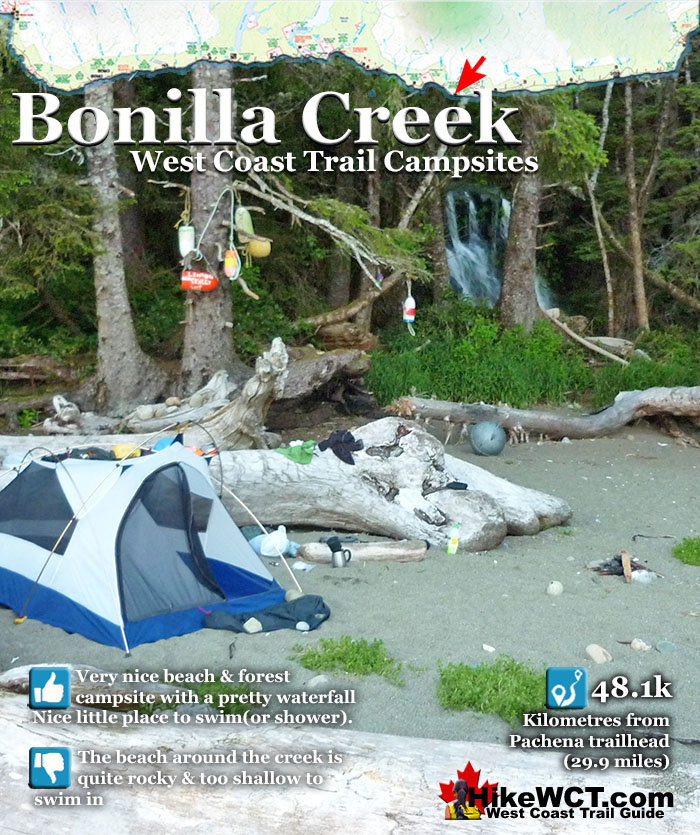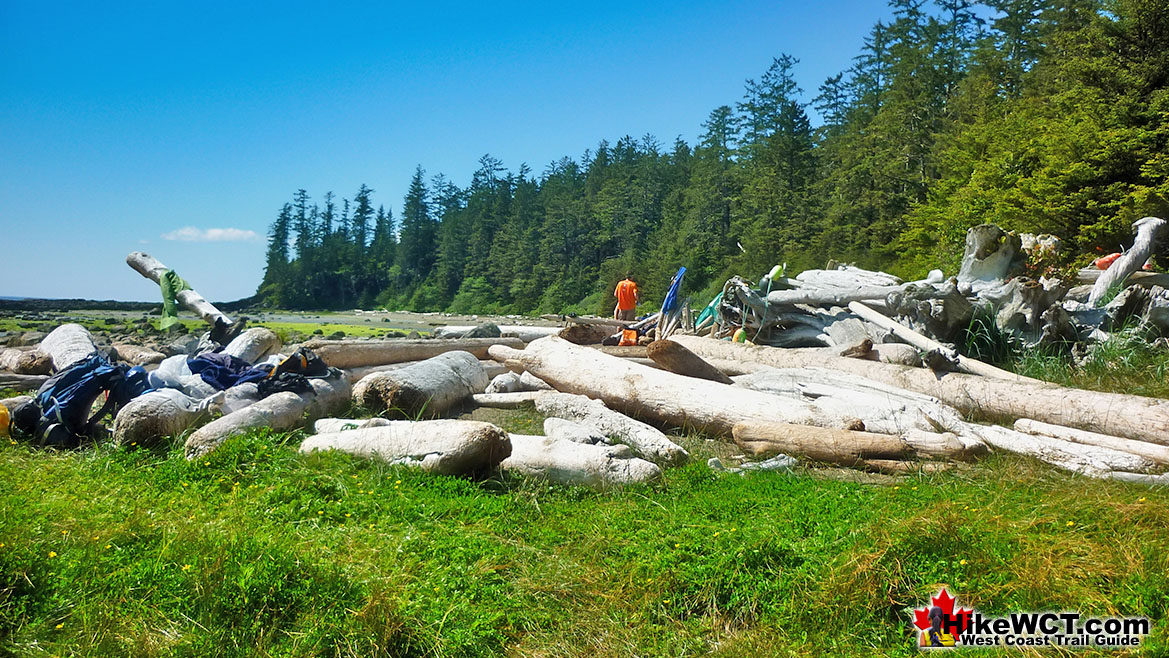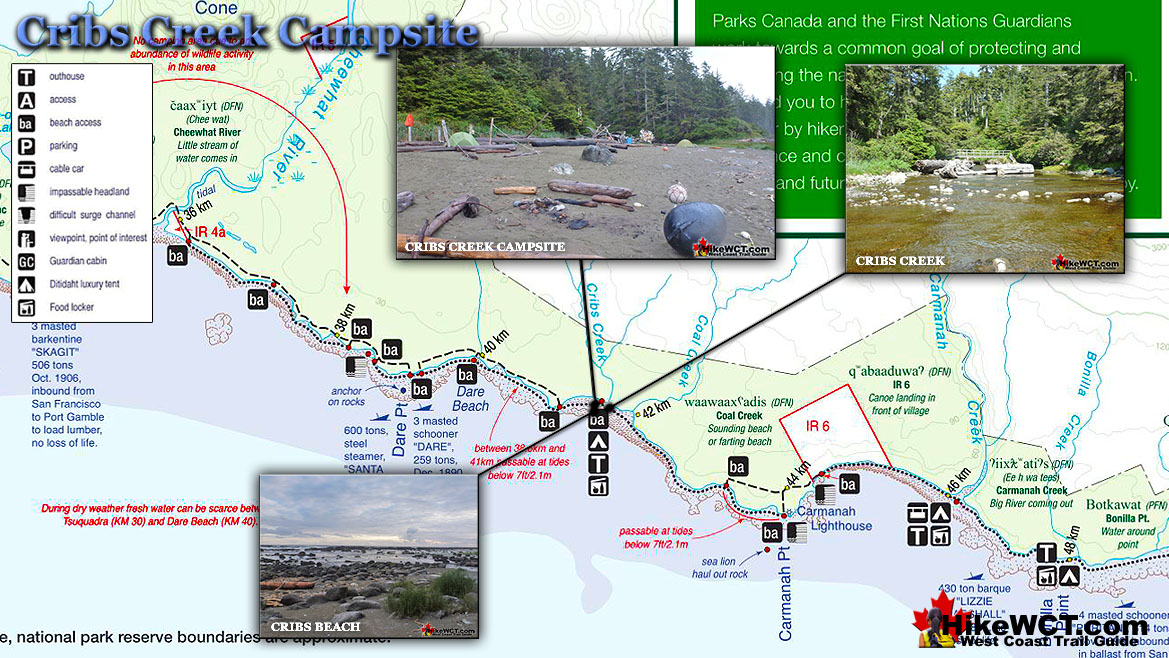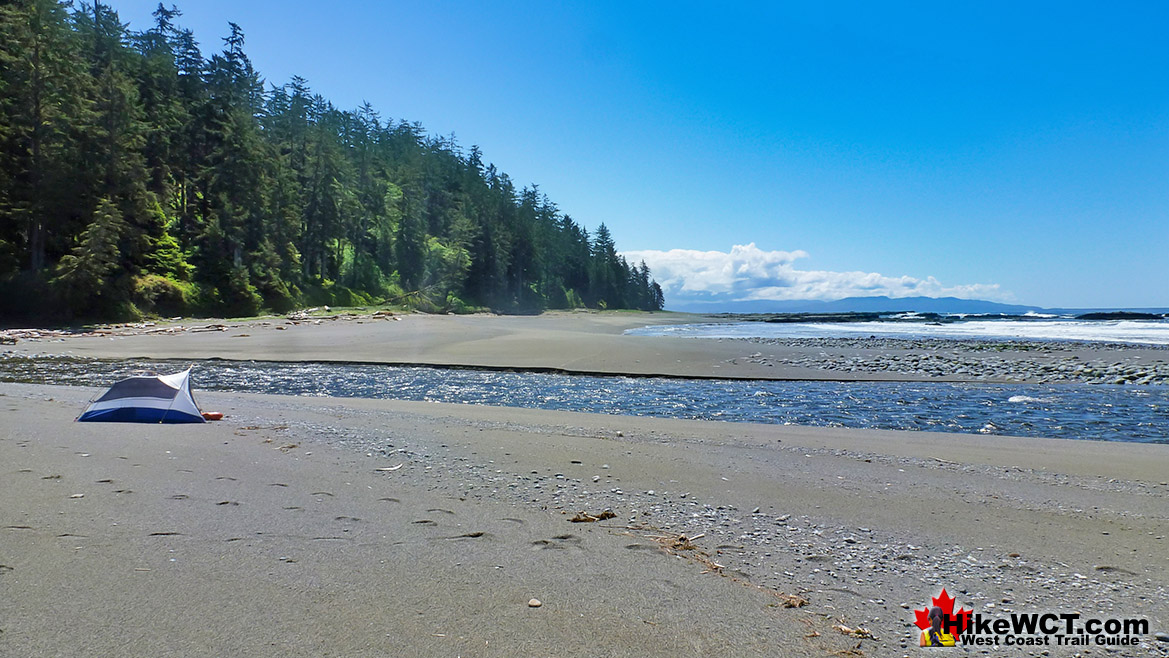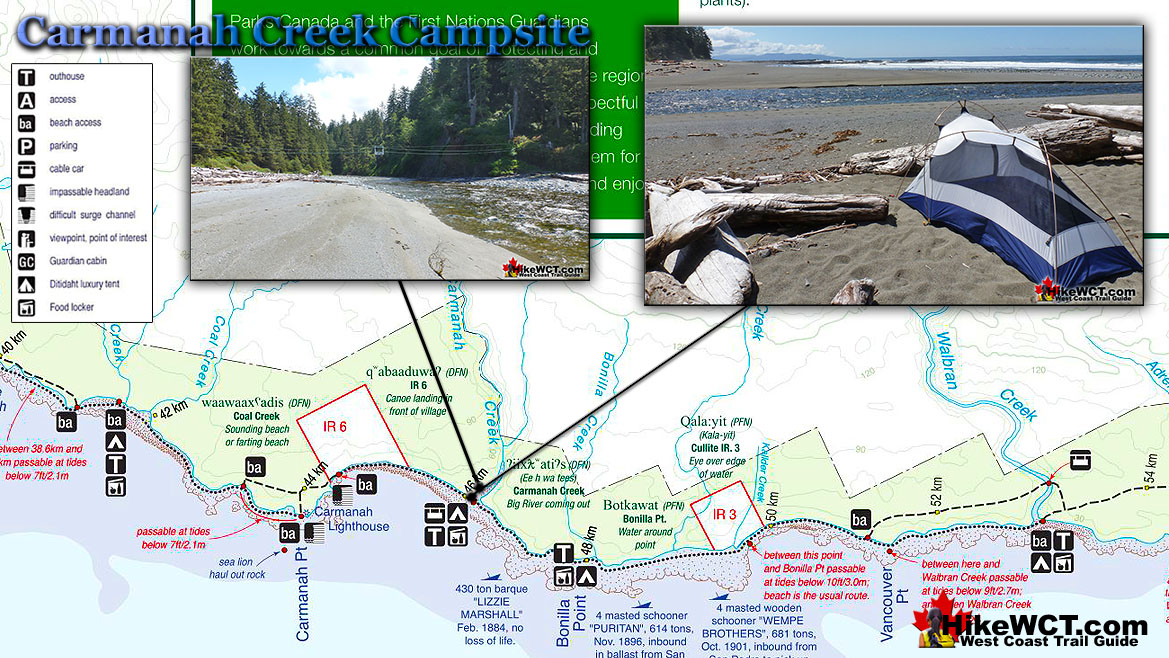![]() The Bonilla Creek campsite at 48km on the West Coast Trail is easy to miss, as it looks very unassuming from the beach. Most hikers pass by Bonilla Falls, which is nestled against a small cliff at the edge of a suddenly deep forest. And the forest hides a nice little world, somewhat sheltered from the elements. An outhouse sits up at the far end, and several tent clearings stretch to the beach where you find a wonderful hammock cobbled together over the years out of old fishing nets and ropes.
The Bonilla Creek campsite at 48km on the West Coast Trail is easy to miss, as it looks very unassuming from the beach. Most hikers pass by Bonilla Falls, which is nestled against a small cliff at the edge of a suddenly deep forest. And the forest hides a nice little world, somewhat sheltered from the elements. An outhouse sits up at the far end, and several tent clearings stretch to the beach where you find a wonderful hammock cobbled together over the years out of old fishing nets and ropes.
 Sensational sunsets visible from your tent
Sensational sunsets visible from your tent Bonilla Falls is unexpectedly beautiful up close
Bonilla Falls is unexpectedly beautiful up close The forest campsite area is very nice & interesting
The forest campsite area is very nice & interesting You can shower under the falls!
You can shower under the falls! Remnants of the Puritan shipwreck nearby!
Remnants of the Puritan shipwreck nearby! Lot of room for tents on the sandy beach
Lot of room for tents on the sandy beach Fresh water is always just steps away
Fresh water is always just steps away Few hikers camp here, or even stop to look
Few hikers camp here, or even stop to look Rock shelf along the shore is not inviting
Rock shelf along the shore is not inviting The beach is not as pretty as other beaches
The beach is not as pretty as other beaches
West Coast Trail Campsites
![]() Michigan Creek at 12km
Michigan Creek at 12km ![]() Darling River at 14km
Darling River at 14km ![]() Orange Juice Creek at 15km
Orange Juice Creek at 15km ![]() Tsocowis Creek at 16.5km
Tsocowis Creek at 16.5km ![]() Klanawa River at 23km
Klanawa River at 23km ![]() Tsusiat Falls at 25km
Tsusiat Falls at 25km ![]() Cribs Creek at 42km
Cribs Creek at 42km ![]() Carmanah Creek at 46km
Carmanah Creek at 46km ![]() Bonilla Creek at 48km
Bonilla Creek at 48km ![]() Walbran Creek at 53km
Walbran Creek at 53km ![]() Cullite Cove at 58km
Cullite Cove at 58km ![]() Camper Bay at 62km
Camper Bay at 62km ![]() Thrasher Cove at 70km
Thrasher Cove at 70km
A bit surreal in such a remote feeling place, but it is so elaborate that it makes you look around for permanent residents! You won't find any permanent human residents, however, you will encounter some wildlife as there always seems to be a bear or two walking the shoreline between Bonilla Point and Carmanah Creek in the early morning hours. The campsite at Bonilla Creek has some beautiful characteristics. First the cute, Bonilla Falls have a perfect little pool to dunk yourself in and wash off the days hiking grime. The falls hide at the edge of the forest and once you reach them you feel like you are in a secluded little world. The falls are often bathed in sunshine and the water lights up to a brilliant green colour. Second, the campsite is quite good with lots of varied places to put up a tent as well as some driftwood structures out on the beach. Within the forest you find all sorts of strange constructions out of things washed up on the beach. At the far end of the campsite you find a characteristically lovely outhouse hidden in the trees. The third wonderful aspect of the Bonilla Creek campsite is the sunsets. They are sensational. Bright orange, with the narrow islands in the distance topped by improbable looking trees. Added to that, you have a relatively quiet campsite compared to other West Coast Trail campsites.

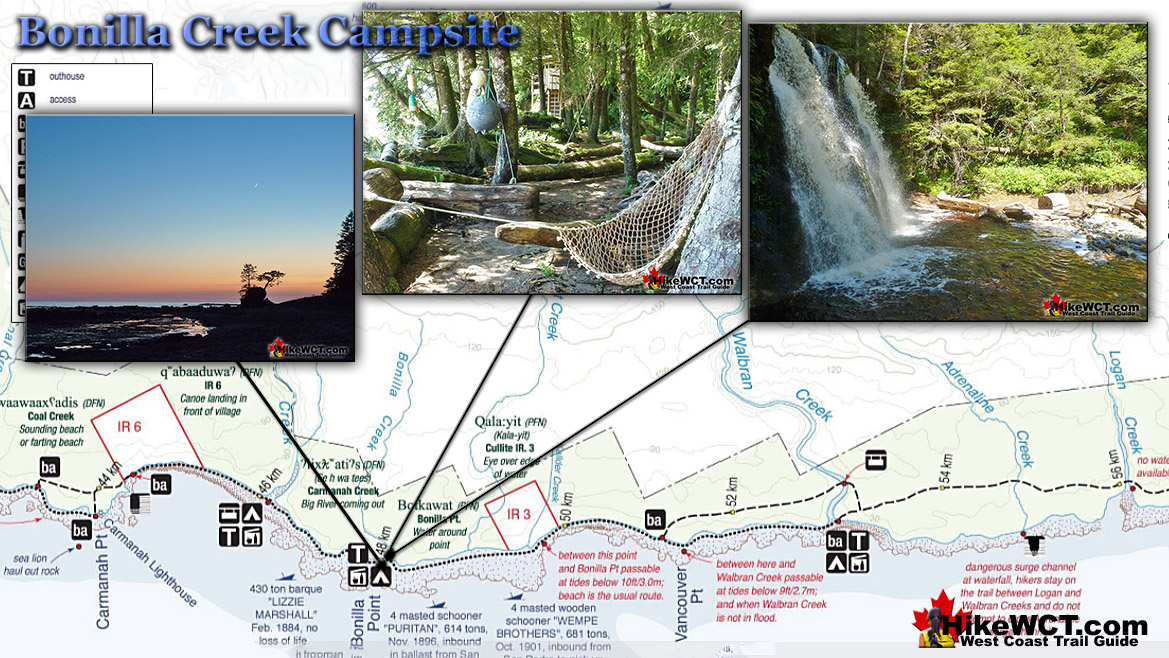
Shipwrecks Near Bonilla Creek - West Coast Trail
The Dare Shipwreck at 39km
![]() You will pass the Dare shipwreck at the 39 kilometre mark of the West Coast Trail. The Graveyard of the Pacific claimed this 3 masted, 269 ton schooner on December 23rd, 1890. The Dare sailed out of San Francisco in ballast for Tacoma to take on a load of lumber. In the middle of the winter, stormy season along this coast, the Dare was caught in a typically brutal storm. The crew fought the high winds and tumultuous seas driving them towards the unforgiving shore of Vancouver Island. The Dare was smashed on the rock shore just three kilometres west of Carmanah Point. The crew, unhurt from the impact of the ship was able to get ashore relatively easily. Luckily for the crew they were soon met by Indians who resided just down the beach. The good folks that ferry West Coast Trail hikers across Nitinaht Narrows are descendants of the rescuers of the crew of the Dare. They were transported to Victoria by canoe by the natives. Their ship was left smashed on the rocks and what could be salvaged or looted was taken away. Today there are no visible remnants of the Dare shipwreck except one marvellous reminder of this brutal coastline, the ship's anchor. The ship crashed onto the rocks quite a distance from the present location of the anchor. However with no other shipwreck contenders in the area, the anchor West Coast Trail hikers stumble pas here is almost certainly the anchor from the Dare. You will see it just past the 38 kilometre mark of the trail laying on the rocks in plain view. Dare Point begins just as you pass the anchor(if hiking from the Pachena trailhead). Further along you will come to Dare Beach, a nice, though narrow patch of beach in an area almost entirely rocky, unforgiving coastline.
You will pass the Dare shipwreck at the 39 kilometre mark of the West Coast Trail. The Graveyard of the Pacific claimed this 3 masted, 269 ton schooner on December 23rd, 1890. The Dare sailed out of San Francisco in ballast for Tacoma to take on a load of lumber. In the middle of the winter, stormy season along this coast, the Dare was caught in a typically brutal storm. The crew fought the high winds and tumultuous seas driving them towards the unforgiving shore of Vancouver Island. The Dare was smashed on the rock shore just three kilometres west of Carmanah Point. The crew, unhurt from the impact of the ship was able to get ashore relatively easily. Luckily for the crew they were soon met by Indians who resided just down the beach. The good folks that ferry West Coast Trail hikers across Nitinaht Narrows are descendants of the rescuers of the crew of the Dare. They were transported to Victoria by canoe by the natives. Their ship was left smashed on the rocks and what could be salvaged or looted was taken away. Today there are no visible remnants of the Dare shipwreck except one marvellous reminder of this brutal coastline, the ship's anchor. The ship crashed onto the rocks quite a distance from the present location of the anchor. However with no other shipwreck contenders in the area, the anchor West Coast Trail hikers stumble pas here is almost certainly the anchor from the Dare. You will see it just past the 38 kilometre mark of the trail laying on the rocks in plain view. Dare Point begins just as you pass the anchor(if hiking from the Pachena trailhead). Further along you will come to Dare Beach, a nice, though narrow patch of beach in an area almost entirely rocky, unforgiving coastline.
Dare shipwreck continued here...
The Lizzie Marshall Shipwreck at 47km
![]() At about 47 kilometres along the West Coast Trail you will pass the final resting place of the Lizzie Marshall. On February 7th, 1884, this 434 ton American ship headed out of San Francisco to an unspecified port in British Columbia. Two weeks later she approached Cape Flattery cloaked in a thick fog. Added to that, the wind died and the Lizzie Marshall drifted with the current. Her sails drenched and barely touched by the breeze, she wallowed along for hours until breakers were heard and Bonilla Point lay right in front of them. The crew dropped two anchors and prayed they would hold them off the perilously close rock shelf. The captain launched a lifeboat to row to Neah Bay, 15 miles away, in the hopes of finding a boat to haul them out of danger. Soon the fog cleared and a southwest gale blew in. Straining against the anchors, the Lizzie Marshall held for a while. However on the morning of February 22nd, the anchors began to drag. In a fit of desperation the crew cut the masts and rigging and dumped them overboard. The idea was to reduce the effect of the wind by lowering the ships profile. This had little effect and the wind continued to increase in strength. The anchor chains were straining against the intense weight of the ship and finally snapped. The Lizzie Marshall was swept broadside into the reef with the stern jammed in between a large gap in the rocks. The crew managed to claw their way across the reef to the shore safely. A short time later one of the crew attempted to get back to the ship to retrieve some of his belongings. He drowned in the attempt. Local native arrived on the scene and began scavenging the wreck as the crew watched from the shore. As they scavenged, their boat was smashed against the rocks, leaving them stranded as well. Eventually a tug arrived on the scene to rescue the crew and natives.
At about 47 kilometres along the West Coast Trail you will pass the final resting place of the Lizzie Marshall. On February 7th, 1884, this 434 ton American ship headed out of San Francisco to an unspecified port in British Columbia. Two weeks later she approached Cape Flattery cloaked in a thick fog. Added to that, the wind died and the Lizzie Marshall drifted with the current. Her sails drenched and barely touched by the breeze, she wallowed along for hours until breakers were heard and Bonilla Point lay right in front of them. The crew dropped two anchors and prayed they would hold them off the perilously close rock shelf. The captain launched a lifeboat to row to Neah Bay, 15 miles away, in the hopes of finding a boat to haul them out of danger. Soon the fog cleared and a southwest gale blew in. Straining against the anchors, the Lizzie Marshall held for a while. However on the morning of February 22nd, the anchors began to drag. In a fit of desperation the crew cut the masts and rigging and dumped them overboard. The idea was to reduce the effect of the wind by lowering the ships profile. This had little effect and the wind continued to increase in strength. The anchor chains were straining against the intense weight of the ship and finally snapped. The Lizzie Marshall was swept broadside into the reef with the stern jammed in between a large gap in the rocks. The crew managed to claw their way across the reef to the shore safely. A short time later one of the crew attempted to get back to the ship to retrieve some of his belongings. He drowned in the attempt. Local native arrived on the scene and began scavenging the wreck as the crew watched from the shore. As they scavenged, their boat was smashed against the rocks, leaving them stranded as well. Eventually a tug arrived on the scene to rescue the crew and natives.
Lizzie Marshall shipwreck continued here...
The Puritan Shipwreck at 48.5km
![]() The Puritan was a 4 masted schooner of 614 tons sailing inbound from San Francisco in ballast. She was heading for Port Gamble in Washington to pick up a load of lumber when the crew failed to account for the strong current in Juan de Fuca Strait. Owing to the thick fog and heavy seas, the Puritan stumbled blindly into the rocks of Bonilla Point. The crew of 10 made the same mistake that hundreds of crews before them made. They didn't reckon their course with the notorious, strong current of the Juan de Fuca Strait. The current pushed them far northwest of their perceived position. Unable to see due to the thick fog, stormy weather and darkness of night the Puritan was pushed into the rocky Bonilla Point. The record shows that she was wrecked at 5am on November 13, 1896. The crew decided to wait for daybreak to figure out their escape. When the morning finally came, a lone Indian found them and battling the surf, managed to run a rope from the ship to the shore. The crew used the life-line to escape the crumbling ship. The Puritan, continuously bashed by the sea until on the following day she was laying her masts in the surf, and quickly began breaking up. The crew made their way to Carmanah Point Lighthouse and later ferried to Victoria. For his heroic efforts, the Indian was reportedly rewarded. Today hiking the West Coast Trail, you will find some of the ship's remains on the outer reef.
The Puritan was a 4 masted schooner of 614 tons sailing inbound from San Francisco in ballast. She was heading for Port Gamble in Washington to pick up a load of lumber when the crew failed to account for the strong current in Juan de Fuca Strait. Owing to the thick fog and heavy seas, the Puritan stumbled blindly into the rocks of Bonilla Point. The crew of 10 made the same mistake that hundreds of crews before them made. They didn't reckon their course with the notorious, strong current of the Juan de Fuca Strait. The current pushed them far northwest of their perceived position. Unable to see due to the thick fog, stormy weather and darkness of night the Puritan was pushed into the rocky Bonilla Point. The record shows that she was wrecked at 5am on November 13, 1896. The crew decided to wait for daybreak to figure out their escape. When the morning finally came, a lone Indian found them and battling the surf, managed to run a rope from the ship to the shore. The crew used the life-line to escape the crumbling ship. The Puritan, continuously bashed by the sea until on the following day she was laying her masts in the surf, and quickly began breaking up. The crew made their way to Carmanah Point Lighthouse and later ferried to Victoria. For his heroic efforts, the Indian was reportedly rewarded. Today hiking the West Coast Trail, you will find some of the ship's remains on the outer reef.
Puritan shipwreck continued here...
The Wempe Brothers Shipwreck at 49.4km
![]() The Wempe Brothers was a 4 masted schooner just 70 tons heavier than the Puritan, that wrecked here a century ago. The Wempe Brothers was sailing in from San Pedro, California in ballast. She was heading for Puget Sound to pick up lumber when she was claimed by the Graveyard of the Pacific. The crew of 10 experienced very stormy weather as she neared the Cape Flattery Lighthouse and entrance to Juan de Fuca Strait. Light winds and thick fog carried them towards the strait, however the fast current pulled them irresistibly north towards the coast of Vancouver Island. The Wempe Brothers was carried so close to the Carmanah Point that the lighthouse lights were reported to be reflected on the ships sails and hull. The crew had no idea they were so far out of their intended position and the sudden appearance of a lighthouse must have been terrifying. The wind was dead calm so sailing to safety was not an option. The crew managed to drop two anchors in a desperate effort to halt the ship before colliding with the shore. It was too late, however, as the Wempe Brothers was carried onto the beach at 5am on October 28th, 1903.
The Wempe Brothers was a 4 masted schooner just 70 tons heavier than the Puritan, that wrecked here a century ago. The Wempe Brothers was sailing in from San Pedro, California in ballast. She was heading for Puget Sound to pick up lumber when she was claimed by the Graveyard of the Pacific. The crew of 10 experienced very stormy weather as she neared the Cape Flattery Lighthouse and entrance to Juan de Fuca Strait. Light winds and thick fog carried them towards the strait, however the fast current pulled them irresistibly north towards the coast of Vancouver Island. The Wempe Brothers was carried so close to the Carmanah Point that the lighthouse lights were reported to be reflected on the ships sails and hull. The crew had no idea they were so far out of their intended position and the sudden appearance of a lighthouse must have been terrifying. The wind was dead calm so sailing to safety was not an option. The crew managed to drop two anchors in a desperate effort to halt the ship before colliding with the shore. It was too late, however, as the Wempe Brothers was carried onto the beach at 5am on October 28th, 1903.
Wempe Brothers shipwreck continued here...
The Duchess of Argyle Shipwreck at 58km
![]() The Duchess of Argyle met her end at the mouth of Cullite Cove back at the 58 kilometre mark of the West Coast Trail. She was a huge, four masted barque with an iron hull and watertight bulkheads. She was sailing in ballast from San Francisco on October 13th, 1887, bound for Vancouver. She would pick up lumber and sail for Melbourne, Australia. Sailing up the coast from San Francisco, the good weather turned bad on October 16th. For almost two weeks a powerful gale hammered the Duchess of Argyle. When the storm finally let up, Cape Flattery Lighthouse was sighted about 20 miles away. The ship, unable to find wind, floated with the current, inching towards Juan de Fuca Strait. Soon a small tug boat arrived to assist the enormous becalmed ship through the strait. They lowered sails and got the hawser aboard to connect the ships. The captain of the tug quickly realized that his vessel was too small to manage such a huge ship rolling in the seas. Cape Flattery was still about 14 miles distant and concealed by fog much of the time. The Duchess of Argyle wallowed in the current until midnight when a strong eastward gale gripped the ship once more. They sailed for Cape Flattery until the wind died again and on November 1st the fog lifted revealing Cape Flattery just 3 miles away. Suddenly the fog returned again, thicker than ever. They crawled forward slowly hoping for the fog to lift again. The fog didn't let up and at 315pm on November 3rd, breakers were heard...
The Duchess of Argyle met her end at the mouth of Cullite Cove back at the 58 kilometre mark of the West Coast Trail. She was a huge, four masted barque with an iron hull and watertight bulkheads. She was sailing in ballast from San Francisco on October 13th, 1887, bound for Vancouver. She would pick up lumber and sail for Melbourne, Australia. Sailing up the coast from San Francisco, the good weather turned bad on October 16th. For almost two weeks a powerful gale hammered the Duchess of Argyle. When the storm finally let up, Cape Flattery Lighthouse was sighted about 20 miles away. The ship, unable to find wind, floated with the current, inching towards Juan de Fuca Strait. Soon a small tug boat arrived to assist the enormous becalmed ship through the strait. They lowered sails and got the hawser aboard to connect the ships. The captain of the tug quickly realized that his vessel was too small to manage such a huge ship rolling in the seas. Cape Flattery was still about 14 miles distant and concealed by fog much of the time. The Duchess of Argyle wallowed in the current until midnight when a strong eastward gale gripped the ship once more. They sailed for Cape Flattery until the wind died again and on November 1st the fog lifted revealing Cape Flattery just 3 miles away. Suddenly the fog returned again, thicker than ever. They crawled forward slowly hoping for the fog to lift again. The fog didn't let up and at 315pm on November 3rd, breakers were heard...
Duchess of Argyle shipwreck continued here...
West Coast Trail Shipwrecks
![]() Alaskan at 4k
Alaskan at 4k ![]() Soquel at 5k
Soquel at 5k ![]() Sarah at 7k
Sarah at 7k ![]() Becherdass-Ambiadass at 8k
Becherdass-Ambiadass at 8k ![]() Michigan at 12k
Michigan at 12k ![]() Uzbekistan at 13.8k
Uzbekistan at 13.8k ![]() Varsity at 17.6k
Varsity at 17.6k ![]() Valencia at 18.3k
Valencia at 18.3k ![]() Janet Cowan at 19k
Janet Cowan at 19k ![]() Robert Lewers at 20k
Robert Lewers at 20k ![]() Woodside at 20.2k
Woodside at 20.2k ![]() Uncle John at 26.2k
Uncle John at 26.2k ![]() Vesta at 29k
Vesta at 29k ![]() Raita at 33k
Raita at 33k ![]() Skagit at 34.2k
Skagit at 34.2k ![]() Santa Rita at 37k
Santa Rita at 37k ![]() Dare at 39k
Dare at 39k ![]() Lizzie Marshall at 47k
Lizzie Marshall at 47k ![]() Puritan at 48.5k
Puritan at 48.5k ![]() Wempe Brothers at 49.4k
Wempe Brothers at 49.4k ![]() Duchess of Argyle at 58k
Duchess of Argyle at 58k ![]() John Marshall at 62.3k
John Marshall at 62.3k ![]() William Tell at 64.2
William Tell at 64.2 ![]() Revere at 69k
Revere at 69k ![]() Cyrus at 75k
Cyrus at 75k
More West Coast Trail Campsites
Cribs Creek Campsite at 42km
![]() Cribs Creek at 42k is a beautiful, clean, and surprisingly emerald coloured creek that flows through the beach campsites. That's about the only nice part about the campsite. The beach is not great, it smells of ageing seaweed, the sandy beach has patches of grass and bushes that give it a messy feel. Unlike many other beaches on the West Coast Trail where you have long sandy beaches carved out by the ocean in giant arcs. At Cribs Creek, you find an irregular and not very attractive beach setting. Still, a nice atmosphere can be created. A lively campfire and a West Coast Trail sunset turns this mediocre beach into decent place to get some rest. Certainly the biggest drawback to Cribs Creek is how busy it always is. Owing to its great distance to the next campsite to the north, Tsusiat Falls, everyone seems to camp here. And they camp here after quite a long day of hiking. Unlike Tsusiat Falls campers, who tend to marvel at the ocean view or stunning waterfalls, at Cribs Creek you find campers busy and focussed on camping and cooking. Skipping Cribs Creek as a campsite is recommended.
Cribs Creek at 42k is a beautiful, clean, and surprisingly emerald coloured creek that flows through the beach campsites. That's about the only nice part about the campsite. The beach is not great, it smells of ageing seaweed, the sandy beach has patches of grass and bushes that give it a messy feel. Unlike many other beaches on the West Coast Trail where you have long sandy beaches carved out by the ocean in giant arcs. At Cribs Creek, you find an irregular and not very attractive beach setting. Still, a nice atmosphere can be created. A lively campfire and a West Coast Trail sunset turns this mediocre beach into decent place to get some rest. Certainly the biggest drawback to Cribs Creek is how busy it always is. Owing to its great distance to the next campsite to the north, Tsusiat Falls, everyone seems to camp here. And they camp here after quite a long day of hiking. Unlike Tsusiat Falls campers, who tend to marvel at the ocean view or stunning waterfalls, at Cribs Creek you find campers busy and focussed on camping and cooking. Skipping Cribs Creek as a campsite is recommended.
Cribs Creek campsite continued here...
Carmanah Creek Campsite at 46km
![]() Carmanah Creek campsite is at the 46k mark of the West Coast Trail. The lovely and large Carmanah Creek slowly flows through this wonderfully massive and very beautiful beach. Plenty of room for plenty of tents. This is one of the beaches that makes you drop your pack, sit on the warm sand and gaze out at the ocean dumbfounded for minutes at a time. The West Coast Trail is something special! There is no shortage of great spots on the beach to put up your tent. You can even put up your tent along the river on the lovely sandy bank. Everybody camps at the unimpressive Cribs Creek campsite just 4 kilometres away, leaving Carmanah Creek a serene paradise. This is one of the campsites where you will want to stay for days, so you might want to include that in your itinerary!
Carmanah Creek campsite is at the 46k mark of the West Coast Trail. The lovely and large Carmanah Creek slowly flows through this wonderfully massive and very beautiful beach. Plenty of room for plenty of tents. This is one of the beaches that makes you drop your pack, sit on the warm sand and gaze out at the ocean dumbfounded for minutes at a time. The West Coast Trail is something special! There is no shortage of great spots on the beach to put up your tent. You can even put up your tent along the river on the lovely sandy bank. Everybody camps at the unimpressive Cribs Creek campsite just 4 kilometres away, leaving Carmanah Creek a serene paradise. This is one of the campsites where you will want to stay for days, so you might want to include that in your itinerary!
Carmanah Creek campsite continued here...
Walbran Creek Campsite at 53km
![]() Walbran Creek at 53k is home to possibly the best, and most unappreciated campsites on the West Coast Trail. It encapsulates so much that makes the West Coast Trail truly wonderful. The expansive beach which seems purpose built for enjoyability is flanked by scenic cliffs and creek on one side, the pacific ocean on the other, and backed by the emerald coloured Walbran Creek that flows through the jungle valley spanned by a cable car crossing! Of the list of pro's and con's for Walbran Creek, the list is hopelessly lopsided to the pro's. Walbran Creek campsite is reached in the middle of the most challenging, invigorating, stunning, bewildering and breathtaking section of the West Coast Trail. The ladders you encounter heading either direction from the campsite are astounding in size. One after another you ascend and descend the most improbably long and slippery, wooden ladders that always feel solid and safe, despite their obvious age and weathering. Even the cable car crossing is exhilarating. It is a very long one and this one in particular invites you to stop midway and take in the stunning view in either direction. Upstream the view is an emerald coloured creek(though it looks more like a river in size), flanked by a beautifully tangled rainforest jungle on either side. The view in the other direction is of the Pacific Ocean framed by trees on either side. Though this image is pretty, it doesn't reveal the true beauty of the campsite that spills out along the beach, just out of view. For most, this cable car glimpse is the closest they get to the Walbran Creek campsite. Such a shame as they are passing a little piece of West Coast Trail paradise. If you do venture down the short side trail to the campsite, almost entirely on the beach you will be instantly surprised by the beach of weather rounded rocks and maze of driftwood logs. Though a beautiful, sandy beach may be your ideal, a pebble beach is a close second. Clean and tidy, you don't get a sleeping bag full of sand. The driftwood logs are semi permanent and have been adjusted over time to create what might be called bedrooms. Little, marvelously segregated, sandy patches ideal for tents. You could be 10 metres from your neighbour and the wall of driftwood logs blocks the sight and sound you might get from others. So you have privacy, which you may not need as Walbran Creek is one of the less visited campsites on the West Coast Trail and where you may find dozens of tents at Tsusiat Falls or Camper Bay. At Walbran Creek you may encounter nobody! At the end of a long day hiking the West Coast Trail, having a nice body of water to wash in.. or better yet jump into is always desired. Walbran Creek flows just steps from your tent, crystal clear, and very inviting. You can swim across the the opposite shore where you will find some small sea caves and a narrow, rocky shore. At the mouth of Walbran Creek, where it meets the ocean you will find a shallow area that is the beach route on the West Coast Trail heading north. It does involve crossing water deeper than most feel comfortable with, so you don't often see people use this route. Also, it avoids the very enjoyable cable car crossing. If you are brave and keen to plunge into the wild Pacific Ocean, you are just steps from that too. You walk straight into the ocean and meet some big breakers. Feel what all the shipwreck survivors felt, scrambling to safety after emerging from the Graveyard of the Pacific. You can plunge into the ocean, then plunge into Walbran Creek moments later as they are separated by a narrow section of beach.
Walbran Creek at 53k is home to possibly the best, and most unappreciated campsites on the West Coast Trail. It encapsulates so much that makes the West Coast Trail truly wonderful. The expansive beach which seems purpose built for enjoyability is flanked by scenic cliffs and creek on one side, the pacific ocean on the other, and backed by the emerald coloured Walbran Creek that flows through the jungle valley spanned by a cable car crossing! Of the list of pro's and con's for Walbran Creek, the list is hopelessly lopsided to the pro's. Walbran Creek campsite is reached in the middle of the most challenging, invigorating, stunning, bewildering and breathtaking section of the West Coast Trail. The ladders you encounter heading either direction from the campsite are astounding in size. One after another you ascend and descend the most improbably long and slippery, wooden ladders that always feel solid and safe, despite their obvious age and weathering. Even the cable car crossing is exhilarating. It is a very long one and this one in particular invites you to stop midway and take in the stunning view in either direction. Upstream the view is an emerald coloured creek(though it looks more like a river in size), flanked by a beautifully tangled rainforest jungle on either side. The view in the other direction is of the Pacific Ocean framed by trees on either side. Though this image is pretty, it doesn't reveal the true beauty of the campsite that spills out along the beach, just out of view. For most, this cable car glimpse is the closest they get to the Walbran Creek campsite. Such a shame as they are passing a little piece of West Coast Trail paradise. If you do venture down the short side trail to the campsite, almost entirely on the beach you will be instantly surprised by the beach of weather rounded rocks and maze of driftwood logs. Though a beautiful, sandy beach may be your ideal, a pebble beach is a close second. Clean and tidy, you don't get a sleeping bag full of sand. The driftwood logs are semi permanent and have been adjusted over time to create what might be called bedrooms. Little, marvelously segregated, sandy patches ideal for tents. You could be 10 metres from your neighbour and the wall of driftwood logs blocks the sight and sound you might get from others. So you have privacy, which you may not need as Walbran Creek is one of the less visited campsites on the West Coast Trail and where you may find dozens of tents at Tsusiat Falls or Camper Bay. At Walbran Creek you may encounter nobody! At the end of a long day hiking the West Coast Trail, having a nice body of water to wash in.. or better yet jump into is always desired. Walbran Creek flows just steps from your tent, crystal clear, and very inviting. You can swim across the the opposite shore where you will find some small sea caves and a narrow, rocky shore. At the mouth of Walbran Creek, where it meets the ocean you will find a shallow area that is the beach route on the West Coast Trail heading north. It does involve crossing water deeper than most feel comfortable with, so you don't often see people use this route. Also, it avoids the very enjoyable cable car crossing. If you are brave and keen to plunge into the wild Pacific Ocean, you are just steps from that too. You walk straight into the ocean and meet some big breakers. Feel what all the shipwreck survivors felt, scrambling to safety after emerging from the Graveyard of the Pacific. You can plunge into the ocean, then plunge into Walbran Creek moments later as they are separated by a narrow section of beach.
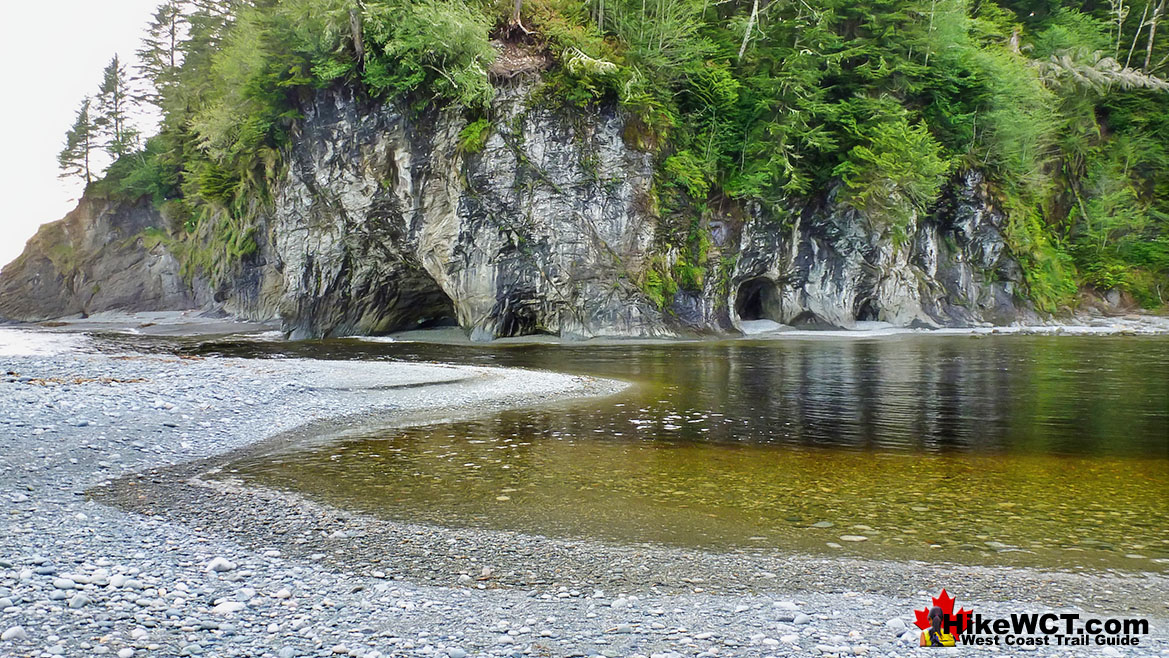

Walbran Creek campsite continued here...
Cullite Cove Campsite at 58km
![]() Cullite Cove is a wonderful campsite on the West Coast Trail at the 58 kilometre mark. Yet another beautiful campsite you will find on the West Coast Trail. It has everything, a lovely wooded area with clearings for tents and campfires. Stunning views all around. A terrific, rocky beach, beautifully hemmed in by beautiful cliffs on either side. Cullite Creek pours into the cove, making for a stunning, albeit freezing swim into the surf. Cullite Cove is a close to perfect as a campsite can get. Cullite Creek is beautiful, crystal clear green, big and slow moving into Cullite Cove, a picture perfect beach hemmed in by majestic cliffs on both sides. Just off the beach, several campsites are laid out, hidden in the trees. Your first thought on seeing this site is to want to stay for a week. The campsite here is often very quiet as everybody seems to camp at Camper Bay just 4 kilometres away and doesn't even drop down the short detour off the main trail to Cullite Cove.
Cullite Cove is a wonderful campsite on the West Coast Trail at the 58 kilometre mark. Yet another beautiful campsite you will find on the West Coast Trail. It has everything, a lovely wooded area with clearings for tents and campfires. Stunning views all around. A terrific, rocky beach, beautifully hemmed in by beautiful cliffs on either side. Cullite Creek pours into the cove, making for a stunning, albeit freezing swim into the surf. Cullite Cove is a close to perfect as a campsite can get. Cullite Creek is beautiful, crystal clear green, big and slow moving into Cullite Cove, a picture perfect beach hemmed in by majestic cliffs on both sides. Just off the beach, several campsites are laid out, hidden in the trees. Your first thought on seeing this site is to want to stay for a week. The campsite here is often very quiet as everybody seems to camp at Camper Bay just 4 kilometres away and doesn't even drop down the short detour off the main trail to Cullite Cove.
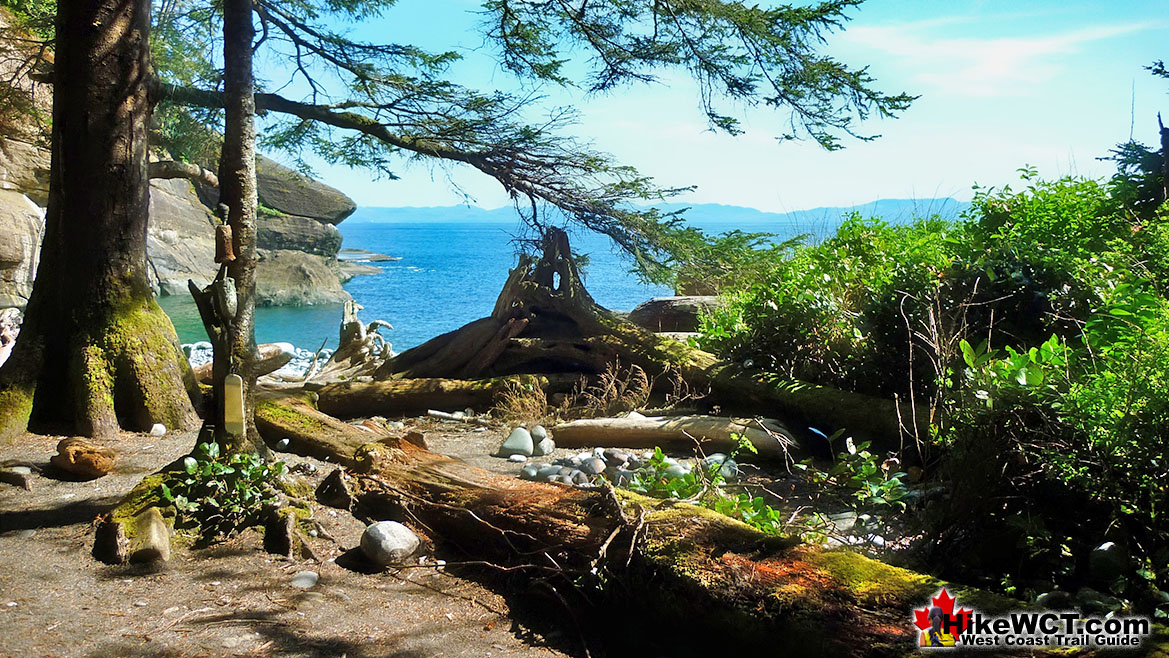
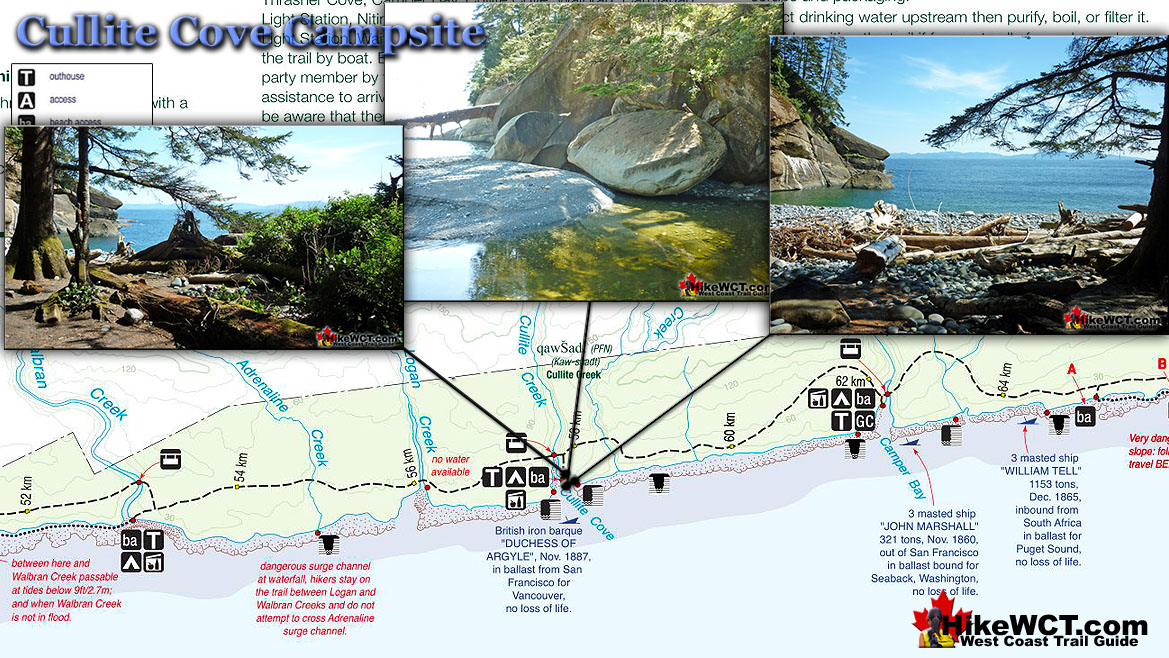
Cullite Cove campsite continued here...
Best West Coast Trail Sights & Highlights
West Coast Trail Campsites
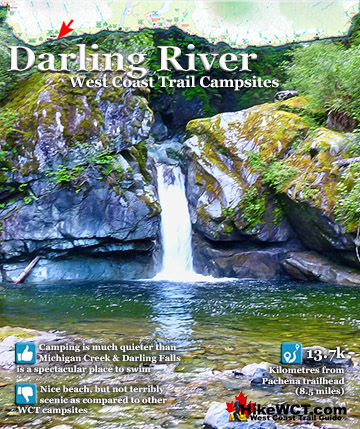
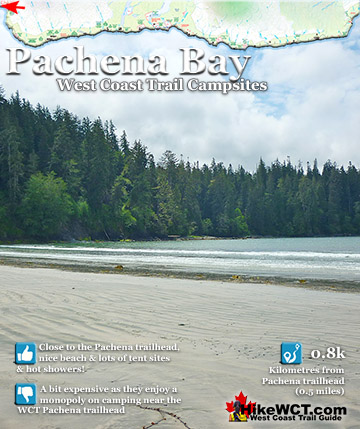
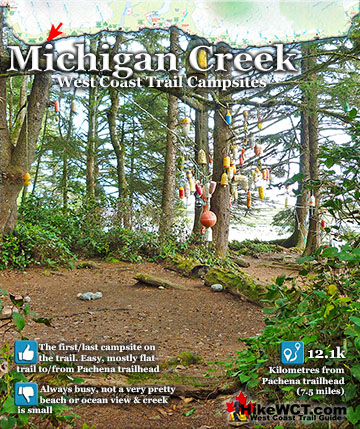
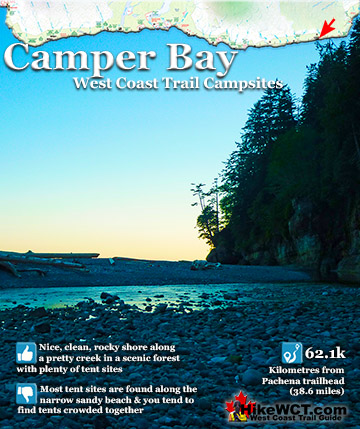
West Coast Trail A to Z
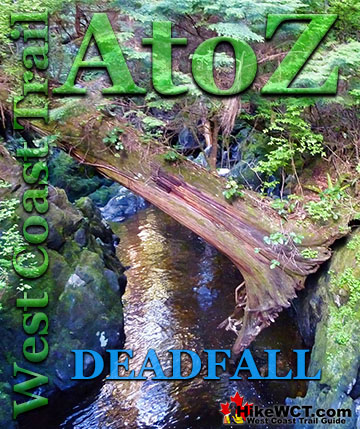
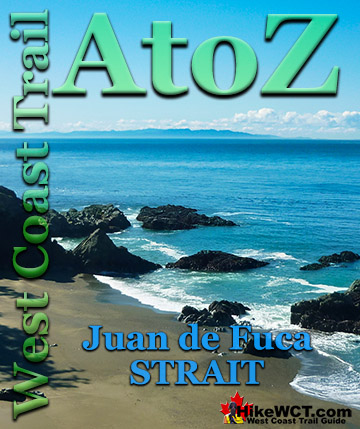
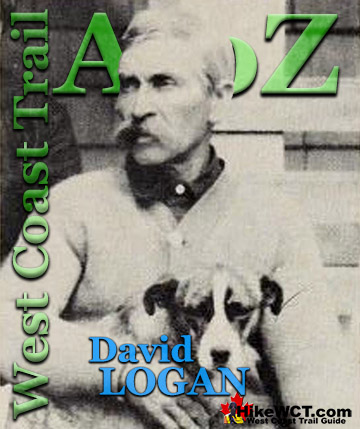
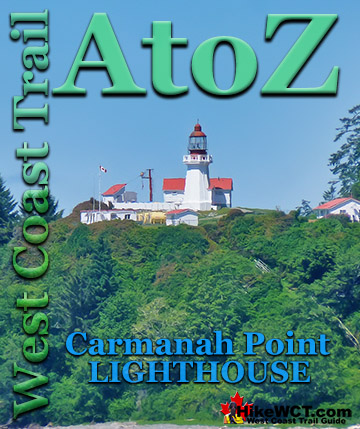
The West Coast Trail by Day
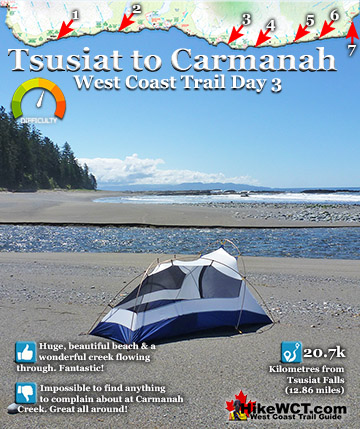
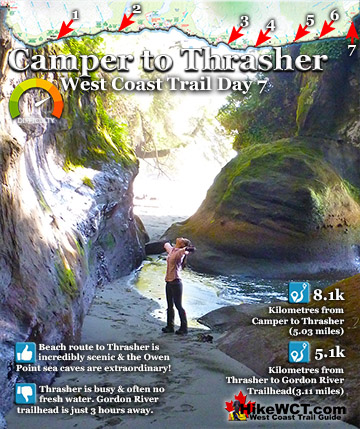
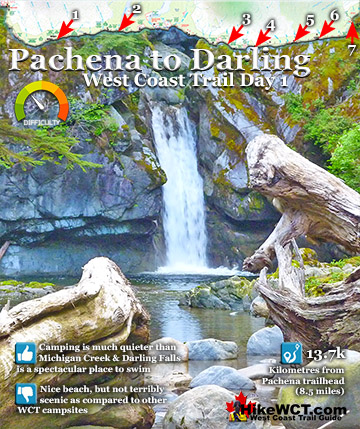
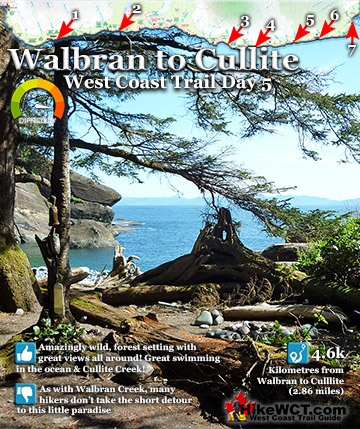
Explore BC Hiking Destinations!
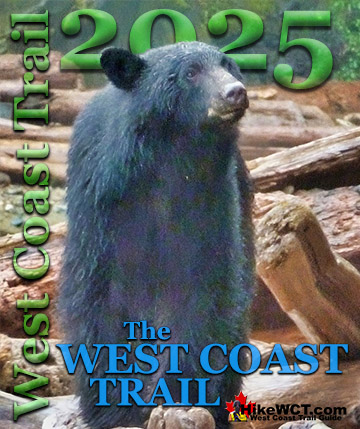
The West Coast Trail

Victoria Hiking Trails
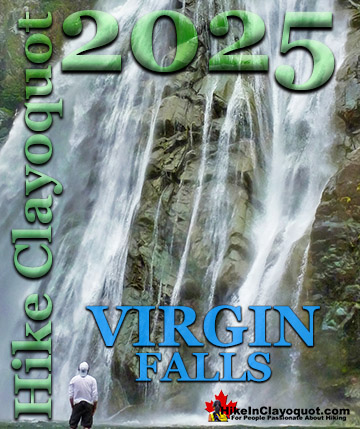
Clayoquot Hiking Trails
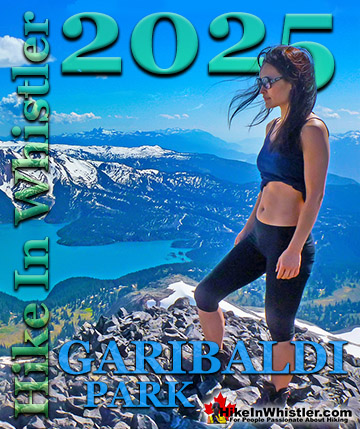
Whistler Hiking Trails
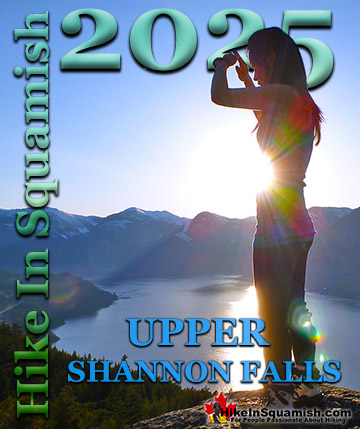
Squamish Hiking Trails

Vancouver Hiking Trails

